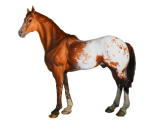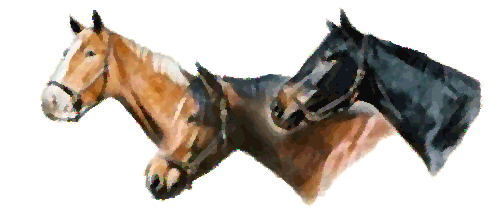
Gaming the Horseby Susan & Garry StahlThis article first appeared in Roleplaying Tips Weekly E-Zine Issue #241 and #242. Check out this site and weekly newsletter for great RPG tips.
Defining the Horse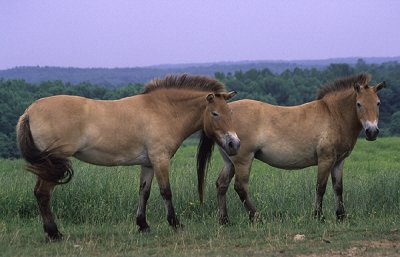 The
average horse is a placid, if skittish, animal. Horses are naturally a
plains-living herd herbivore. They are prey animals and have those
traits that aid survival in that environment. Good hearing, good smell
and eyesight, swift legs. Horses are strong. All these traits looked
good to some ancient hunter, and he decided that he would rather ride
the horse and get it to work for him than eat same. (Of all the figures in history, I would like to meet that genius.) The
average horse is a placid, if skittish, animal. Horses are naturally a
plains-living herd herbivore. They are prey animals and have those
traits that aid survival in that environment. Good hearing, good smell
and eyesight, swift legs. Horses are strong. All these traits looked
good to some ancient hunter, and he decided that he would rather ride
the horse and get it to work for him than eat same. (Of all the figures in history, I would like to meet that genius.)The average horse avoids the unknown. The unknown might eat it. The horse's first reaction to perceived danger is to run. Danger might eat it. You can see that not getting eaten is high on the horse's agenda. Other than battling other horses for dominance, a horse will fight only if there is no other choice. They much prefer to flee. Training can somewhat counteract these instincts but it can never eleminate them totally. In the wild horses form brood bands. A number of females and young, and one stallion. In domestic circumstances horses likewise seek "herds", other horses or, lacking other horses, they will form attachments to animals of other species, even humans. This is one of the ways man binds the horse to him. A horse is sexually capable at the age of two. Gestation is 11 months long and mares will generally have their first foal at age three. Male horses are driven out of their birth band by their herd stallion as they approach sexual maturity. These youngsters will band together in small "bachelor" herds until they are strong enough to challenge an existing herd stallion for control of the herd, or at least to steal a few mares. For this reason, stallions in the wild will not usually sire their first foals until age four, five, or even six. A mare will have one foal, and only one foal, per year, usually born in early spring. Successful births of twins are exteremly rare. Only ONE successful birth of triplets has ever been recorded. Being that these circumstances are so rare, it is assumed they do not happen for game purposes.
The average horse can: More Horse Questions & Answers The Types of HorseHorses come in a number of sizes that have been bred by man from the wild stock for various jobs. The most common broad divisions are listed here. Many breeds fall into these broad categories having been developed separately around the world for much the same work. A good horse breed book with brief descriptions can cover several hundred pages. Defineing breeds* is not the propose of this article.All horses and mules are measured at the withers, which is the highest point on the shoulder where the body joins the neck. They are not measured from the head as that moves around too much. The accepted measuring unit for a horse is the "hand" which equals four inches. A horse that is 14 hands tall will be 56 inches at the withers. We are using inches for greater clarity.
Small pony: under 44", under 400#
Buying a HorseShould you seek a random horse the market will contain these types. If the Game Master wishes to randomly roll of the color of the horse these tables can be used. Likewise unusual traits, both good and bad, can be checked for. Keep in mind that the seller will do their best, as their ethics allow, to promote the horse's good traits while minimizing the bad ones. Most horses are simply average for their size and type and use the performance given above.
Weanlings cannot be
worked, but they are the best age to acquire a horse you wish to bind
to you and train. Note: Those specifically looking for a weanling have
a better chance of finding one if they visit a breeding farm. Yearlings
stand twice the normal chance of breakdown if worked or trained. Other
than teaching manners and basic ground training, a horse's formal
education should begin no earlier than age three when the animal has
reached its full height and weight. Horses from young adult onward can
be worked normally.
Explanation of TraitsAgile: The horse can stop and/or change directions very quickly and take jumps at speed. +10% on any dex check for the horse.Alert: This horse notices things at once. He see and hears the environment ready, but does not panic. He notices and responses to the slightest cues. A handler that is in tune with the horse adds 5% to his own spot or "notice" checks. Any rider has a 10% plus to his horsemanship rolls on this horse. An Alert horse makes you look good. Ambler: A horse that can amble has an extra gait other than the usual walk, trot, canter, and gallop. It is a gait that is extremely comfortable for both horse and rider. An ambling horse can cover a great deal of ground at a rapid rate (12 miles per hour) without tiring. The gait is smooth enough that the rider can balance a full glass of wine on their head without spilling a drop. An Ambling horse can travel at trot speeds with walk fatigue levels. Balker: The horse will refuse when asked to perform ordinary tasks within its ability. The horse may simply stand rooted to the ground, back up, or even sit down. Such an animal can usually be persuaded to do the job, but it will be a battle of wills and strength between the animal & handler. A balker requires horsemanship checks at any new task and at a 10% penalty. Biter: The horse will unpredictably bite whoever is within reach for no reason even though the person being bitten may be doing nothing more than feeding the animal. Clumsy: The horse seems to have four left legs. They will back into things, stand on handlers' feet, or trip over thin air when walking. They tend to have many scrapes, scratches, and patches of missing hair. This horse subject the rider to a -10% penalty on horsemanship checks for any activity other than straight and level riding.
Courageous: The horse displays great boldness and
determination. Such a horse will go into dangerous situations without
fear. When faced with a potential enemy, the horse will prepare to
fight rather than flee. Providing the horse doesn't sense danger,
unusual sights, smells, or sounds are things to be investigated. As
with the willing horse, the courageous one will tax itself to the point
of utter exhaustion, and beyond if the handler does not control it. It
will show no signs of fatigue, but will gallop on until it drops dead
or will continue to try to perform despite wounds or broken limbs, and
will actually fight the handler's efforts to restrain it. A courageous
horse never checks for morale or fatigue. Cribber: This is a vice usually brought on by boredom. The horse chews the top of its stall wall or fence & swallows air. It is a difficult vice to cure, but the behavior can be curbed with the use of a muzzle or cribbing collar. Not only do they damage their surroundings, cribbers are prone to colic and bloat due to the air they swallow. Cribbers will suffer a 20% penalty in disease checks when stabled for any length of time (over 3 days). Dullard: This horse is lights on, no one home. His mind, if he has one, is on something else. Once you get his attention he is willing enough, but that loose mind keeps wandering. A Dullard takes 20% more time and effort to train. They impose a 5% penalty on horsemanship checks. A Dullard is not a safe animal, as they are usually the first ones the predator gets. They give the rider no clues to the environment. Easy Keeper: The horse has no trouble staying at a good weight and glossy coat with minimal feed and care. A handler must be careful not to overfeed as an easy keeper is prone to fat. An easy keeper requires 10% less time and money to maintain. Fleet: If the horse is a saddle horse it will be an exceptionally fast runner. If the horse is a carriage horse it will be an exceptionally fast trotter. Fleet horses are 10% faster at all gaits. Hard Mouth: The horse's mouth has been made insensitive by misuse of the bit and reins. Such animals are difficult to steer or stop without the use of a very severe bit. Horsemanship checks on this horse are made at a 10% penalty. It isn't unwilling, it can't feel the cue. Hardy: This horse is tough. Circumstance that would break another animal are to him a challenge to over come. He has bones of ivory and muscles of steel cord. A hardy horse makes all health or injury checks at a 10% bonus.
Intelligent: This could be a blessing or a curse,
depending on your point of view. An intelligent horse has a strong
sense of self-preservation. If they feel a shoe loosen they will refuse
to go any further until the shoe has been fixed. If they detect danger
they will not willingly proceed into the situation. Novice handlers may
mistake this for stubbornness, while experienced handlers will
recognize it as good common sense. It is difficult to force such a
horse to move toward the danger. However, a well-loved and trusted
handler can often convince the animal to go on despite the horse's
natural instincts. Intelligent horses make poor war horses. (Go THERE?
Things are getting KILLED in there boss.) Intelligent horses tend to
get bored easily. If they are confined for too long without sufficient
work to do, they will INVENT things to amuse themselves (digging a hole
in the stall, grabbing objects within reach and flinging them about,
etc.) Such boredom can be avoided by giving the horse plenty of work to
do and/or providing a toy for the animal to play with. Jumper: The horse can jump higher and further than other horses. The jumper can clear 20% greater height or length than the average horse. Kicker: The horse will kick anyone within range given half a chance. Loyal: The horse will obey only one master. It will do everything within its power to return to that master if stolen or sold. Should the master fall, the horse will stay by the master's side & protect him/her. The horse will actively attack anyone or anything threatening its master. Such an animal will obey no other person unless that person is known by the animal to be important to its master. The horse's loyalty can be transferred to another master, but it will be several weeks or months work on the part of both people. Nervous: The horse sees enemies around every corner and in every bush. It is very much of the opinion that everything is guilty until proven innocent. It is also of the opinion that everything is out to get it. A leaf that suddenly skitters across the horse's path is sufficient cause to jump sideways or backward. Unusual sounds or smells will cause the animal to sweat and tremble with fear. The animal may bolt in panic or stand fearfully depending on its relationship with the handler. A trusted handler will be able to get the horse to move past its fear with patience. Horsemanship checks are required at any new incident. Poor Doer: Opposite of easy keeper. The horse always seems to be underweight & have a poor coat despite adequate feed and care. They can be improved with feed supplements and diligent grooming. The condition can be caused by internal parasites and/or bad teeth. This horse will cost 10% more time and money than a normal animal to keep in good condition. Rears: The horse will attempt to avoid work by rearing. A handler on the ground will usually be threatened by waving front hooves. A rider may find themselves in the dirt if they are not ready for the behavior. In some extreme cases, the horse will deliberately throw itself over backward with a rider on its back. Horsemanship tests are required to ride this animal. Restricted: This horse, through flaws in conformation or due to old injury, cannot move as easily as other horses. He suffers a 20% penalty in speed and jumping ability. Rough gaited: The horse rides like it had five legs, or like you are sitting on a jackhammer. The rider will becomes overly fatigued on this horse and really nothing can be done about it. Break him to harness. A variation is the horse that is rough gaited in only one gait, such as the trot, but easy to ride at the walk, canter, or gallop. Runaway: The horse will attempt to avoid work by bolting at top speed. Such an animal must be kept on a tight rein to avoid the behavior. They will be difficult to stop once they get going and a novice handler is likely to find themselves sitting in the dirt. Smooth Gaited: The horse has only the normal gaits, but is more comfortable than usual to ride. The rider suffers less fatigue from riding this horse. Steady: This horse take unusual sight, sounds, and smell with utter equamity. You could run a marching band and full fireworks display past him and he yawns and wonders what's for dinner. (grain... my favorite...) This horse will take his cues from his handler or rider. If the "herd leader" is fine, he is fine. This horse ignores "horsey" fear checks in the presence of a human he trusts, and will only "fail" other checks if his rider/handler does. Stayer: The horse has exceptional stamina. It will go a third longer than a normal horse before requiring fatigue checks. Strong: All horses are strong, but some are stronger than most. A horse with this trait can haul a lot of weight for its size. A strong horse can haul or carry 10% greater load than average horses. Sullen: The horse has a bad attitude. It must be forced to perform and then the performance will be lackluster with pinned ears & clamped tail. What work is done will be done with the least amount of effort the horse can get away with. Every command to the horse requires a will or horsemanship check. The horse will be 10% less able in all categories of performance even if it does move. Sure-footed: This horse can keep it's feet in difficult circumstances such a mud, ice, or loose ground that would cause other horses to stumble. Sure-footed horses have a 10% bonus to any dex check. Unsound: This horse has a tendency to go lame with any hard work. Any effort that requires a fortitude or constitution check requires an additional check to see if the horse goes lame. A lame horse cannot be ridden or draw a load without risking a total breakdown that will effectively destroy the animal. Each episode of lameness will require 1d4 weeks of rest and care to correct. The horse must be maintained as if working to simulate the vet visits and treatments. Weak: A weak horse is still strong, but for physical reasons cannot carry the load an average horse can. A Weak horse can carry or pull 10% less for their size than an average horse. Willing: The horse will do its very best to obey its handler's commands, even if it doesn't quite understand what's being asked of it. The handler of such an animal must be careful what they ask their horse to do. If being asked to gallop for an extended period of time, the horse will slow as it becomes fatigued, but it will continue to gallop if the rider insists. If asked to jump a fence too tall for it, the horse will show reluctance to do so, but will make its best attempt at the rider's insistence. Such a horse will tax itself to the point of utter exhaustion to try to fulfill its handler's wishes. A willing horse requires no horsemanship tests even for the most difficult tasks, except to determine if the rider stays in the saddle.
*Additional information on Horse Breeds can be found in these books and websites.
**These color tables are based on a simplification of the real
incidence of horse color genetics as currently understood by science.
For further information check the following books and websites.
Return to The Greyhawke Campaign Copyright © Garry & Susan Stahl: October 2004. All rights reserved, re-print only with permission.
|
||||||||||||||||||||||||||||||||||||||||||||||||||||||||||||||||||||||||||||||||||||||||||||||||||||||||||||||||||||||||||||||||||||||||||
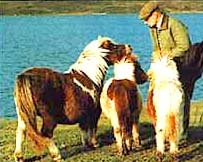 Small Pony:
These horses are commonly used in tight spaces. They are often referred
to as Mine Ponies as that is the work they are bred to. Such work is
hard on the animals and in such conditions life is short and brutal.
More refined breeds of the small pony are used as companion animals for
larger horses or even people.
Small Pony:
These horses are commonly used in tight spaces. They are often referred
to as Mine Ponies as that is the work they are bred to. Such work is
hard on the animals and in such conditions life is short and brutal.
More refined breeds of the small pony are used as companion animals for
larger horses or even people.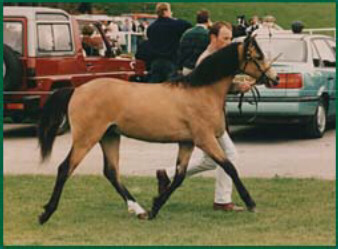 Pony: The
pony is the natural size of the wild horse. Ponies are strong for their
size. While they cannot carry more than their weight would suggest they
are stronger pound for pound that the large draft horses. A pony can
drag 75% its body weight and pull 200% its body weight.
Pony: The
pony is the natural size of the wild horse. Ponies are strong for their
size. While they cannot carry more than their weight would suggest they
are stronger pound for pound that the large draft horses. A pony can
drag 75% its body weight and pull 200% its body weight.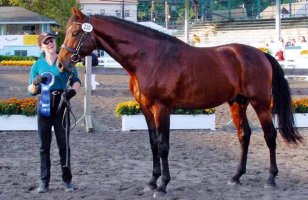 Saddle horse: This
the horse most people think of when you say "horse". They are average
in all respects and are best sized for riding.
Saddle horse: This
the horse most people think of when you say "horse". They are average
in all respects and are best sized for riding.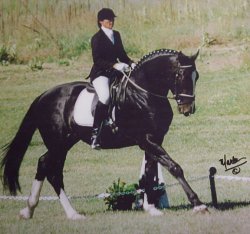 Carriage / Light war horse:
While the two types are similar in size they differ in conformation.
The Carriage horse will be longer in the back and of a more placid
temperament. The War horse is like a large saddle horse, and the
trainer of war horses seeks a more fiery temperament. The type is also
called the "warmblood".
Carriage / Light war horse:
While the two types are similar in size they differ in conformation.
The Carriage horse will be longer in the back and of a more placid
temperament. The War horse is like a large saddle horse, and the
trainer of war horses seeks a more fiery temperament. The type is also
called the "warmblood". Light draft / Heavy war horse: This
size of horse is the largest one that can comfortably be ridden for any
distance. These larger horses again differ mostly in temperament. The
draft breeds are phlegmatic, suited to the work they do both on the
farm and in the city. A teamster cannot afford an excitable animal.
Likewise, the farmer does not consider an excitable animal acceptable.
War horses are bred for the choleric fire to sustain them in battle.
Light draft / Heavy war horse: This
size of horse is the largest one that can comfortably be ridden for any
distance. These larger horses again differ mostly in temperament. The
draft breeds are phlegmatic, suited to the work they do both on the
farm and in the city. A teamster cannot afford an excitable animal.
Likewise, the farmer does not consider an excitable animal acceptable.
War horses are bred for the choleric fire to sustain them in battle.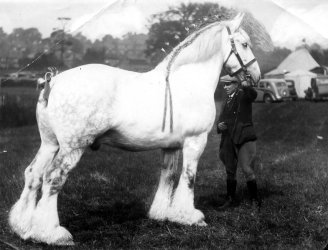 Heavy draft: These
are the largest of the horse types. They are too broad of back to be
comfortably ridden. They work only in harness. Often called the "gentle
giants" they are bred for a placid nature, agreeable to work. One
cannot afford horses of this size that are temperamental.
Heavy draft: These
are the largest of the horse types. They are too broad of back to be
comfortably ridden. They work only in harness. Often called the "gentle
giants" they are bred for a placid nature, agreeable to work. One
cannot afford horses of this size that are temperamental.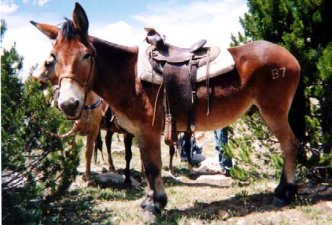 Mules: Mules
are a cross between a horse mare and a donkey jack, or male. This
sterile hybrid produces a creature with the best traits of the parents.
The strength and willingness of the horse, and the intelligence and
good sense of the donkey. Female mules are called "mares" as are their
horse cousins, while male mules are called "johns". All male mules are
gelded. They may be sterile, but have more urge than even a healthy
horse. As it interferes with work, it must curbed. Mules are valued as
both saddle and draft animals. All mules have the traits intelligent, sure-footed, and strong. They are as prone to vices as any horse.
Mules: Mules
are a cross between a horse mare and a donkey jack, or male. This
sterile hybrid produces a creature with the best traits of the parents.
The strength and willingness of the horse, and the intelligence and
good sense of the donkey. Female mules are called "mares" as are their
horse cousins, while male mules are called "johns". All male mules are
gelded. They may be sterile, but have more urge than even a healthy
horse. As it interferes with work, it must curbed. Mules are valued as
both saddle and draft animals. All mules have the traits intelligent, sure-footed, and strong. They are as prone to vices as any horse.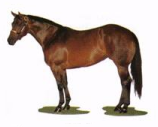

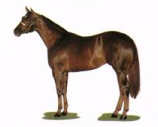
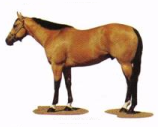

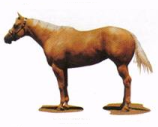
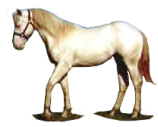
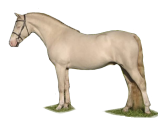
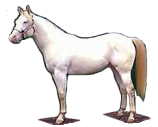
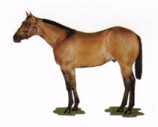
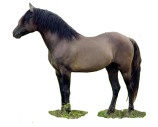
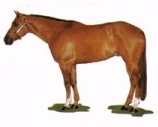

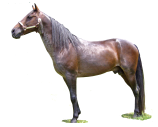
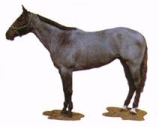
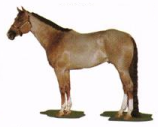
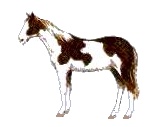 (Roll again to see if the horse is solid white. 95 - 100 indicates an all white animal.)
(Roll again to see if the horse is solid white. 95 - 100 indicates an all white animal.)